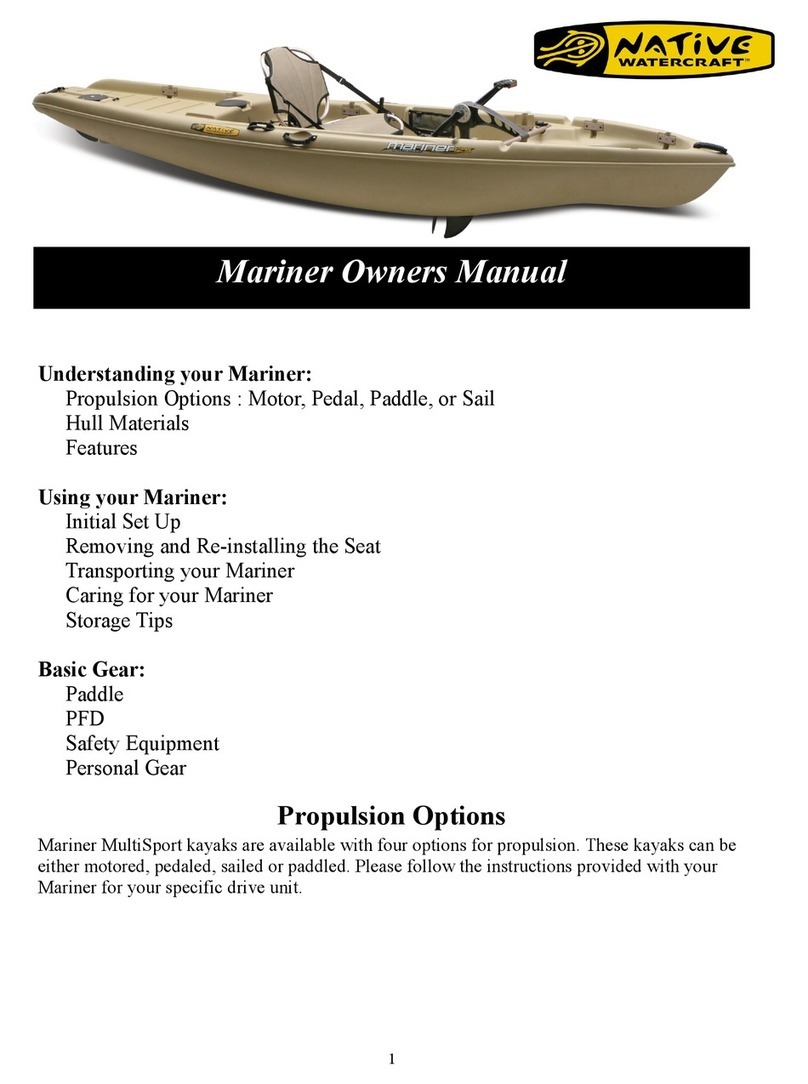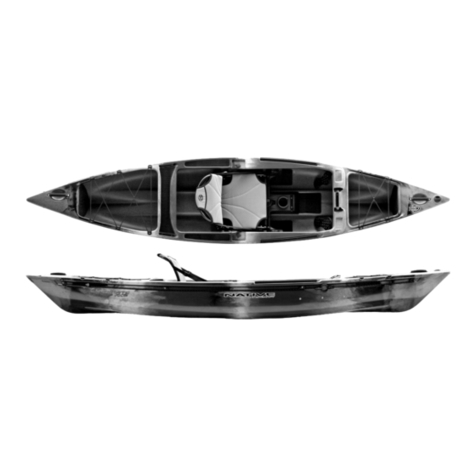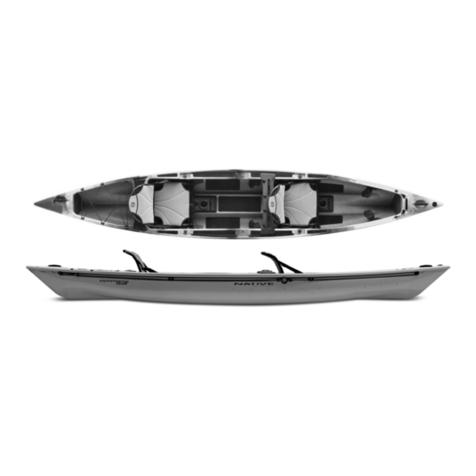Native Watercraft Inuit User manual

1
Inuit Owners Manual
We have advanced the design and comfort level of the Inuit series beyond any other touring kayak. The Tru-Track hull offers straight tracking
despite the shorter hull length plus it provides a high level of maneuverability. 5 Star Seating raises the standard for outfitting as it supports and
cushions all day.
Inuit 13.5

2
Get To know your Inuit
Hull Materials
Polyethylene
Rotationally molded boats are engineered to have sturdy hulls with maximum impact and abrasion resistance. Polyethylene can endure extended ex-
posure to both ultraviolet light and temperature variation, enabling boats to be stored outdoors. When you are paddling a Native Watercraft kayak you
can focus on your paddling experience knowing that your boat will perform for you on every trip.
FEATURES
Tru Track Hull
The Tru Track Hull employs a uniquely layered design that creates several chines in the hull. The additional chines
allow the hull to track as well as longer kayaks but turn and maneuver as well as, or better than, other kayaks of their
length.
The hull is also stronger and more stable because of the extra chines. The chines provide rigidity to the hull to reduce depressions without requiring a
lot of extra plastic to help keep the boat light.
Easy Foot™ Footbrace System
The Easy Foot™ Footbrace System makes it easy to adjust your foot pad position while seated. The foot pads
are sized to specifically suit your boat. Adjust the footpad by either pushing or pulling adjustment rod.
5 Star Outfitting Seat
The 5 Star Outfitting system cradles you in comfort to prevent soreness or stiffness even after a full day's pad-
dle. The vertically and horizontally adjustable seat back provides support for everyone, no matter height or
paddling style. The hip pads can have extra padding added to form fit the soft breathable material around you.
Thigh pads cover adjustable thigh braces for added comfort and steering control.
The entire seat assembly can be adjusted front to back by loosening the seat bolt screws while holding back
the nut on the inside of the seat riser.

3
Paddle holders
The Inuit series is equipped with two paddle holder areas*. They are located on the left and right of the back
deck, immediately behind the seat. The paddle holders are used by simply hooking the stern deck bungee over
the paddle shaft and hooking the bungee to the black nylon hook.
*Inuit kayaks with the rudder option will only have the paddle holder components on the left side.
Hatch Storage
The forward and rear hatch is accessible by a large hatch cover. It allows you to get to your gear quickly and
easily, tethers to the boat so they won’t get lost, and creates a waterproof seal.
The Inuit 12.5 is equipped with large hatch access covers on the bow and stern decks. The Inuit 13.5 and 14.5 have an additional 5” round storage
hatch located on the deck behind the seat.
To open the hatch:
1. Find the finger lift tab molded to the hatch cover.
2. Insert fingers under that tab, and lift the hatch cover gently pulling it up and away from the boat.
To seal the hatch:
1. Find the thin molded tab on the narrow end of the hatch cover and insert it into the recess on the hatch rim.
2. Gently press the hatch cover onto the hatch rim by working your way up toward the wider end of the hatch cover.
Gear should be stowed in such a way that it won’t shift or slide while underway, possibly impeding the safe operation of your kayak. Heavier items
should be stored toward the bottom of the kayak, with lighter items on top. We recommend stowing gear in waterproof bags unless it can get wet with-
out harm. It is also wise to tether gear stored to the seat or to other stowed items so that if you capsize, the gear will remain with the boat.
Inuit 14.5 shown with rudder

4
Rudder
A rudder assembly is an option available to all Inuit models. Rudders
can either be factory installed or purchased as an aftermarket option
with Native Watercraft part number ARUD006.
Deploy and Retract your rudder blade— Pull the rear barrel knot on
the rudder rope to deploy your rudder blade. The other knot will slide to
the rear position. Pull the other knot forward to retract the rudder blade.
Foot pedal rudder controls— Adjust the straps on the foot pedal rudder controls and use the foot pedal controls to pivot your rudder blade to the de-
sired position.
Adjusting your Five Star seat and thigh braces:
Adjust the seat and for your comfort.
For a more erect position, tighten the side straps by pulling the free strap ends toward you.
For a more relaxed position, sit up so that the side straps are supporting you, but not stretched
tight. Gently pull the rounded end of each strap buckle up and away from the strap. The strap will
lengthen and loosen until you’ve found your desired position.
The seat back of the five star seat can be raised and lowered for added comfort. Use the strap and
buckle on the backside of the seat to help hold the seat back in the raised position.
Adjust the thigh braces for your comfort.
The thigh braces can be adjusted for an optimum fit by loosening the (2)thigh brace screws and
sliding the thigh brace to a comfortable location. Retighten after adjustments.
Adjust your Easy Foot footbrace
Unweight the pads.
Pull or push the adjustment bar until the footpad is in the desired position.
When you feel the foot pad click into place on the track, let go of the adjustment bar.
Transporting Your Inuit
To transport your kayak securely, we suggest that you install a rigid bar, sport rack system on the roof of your vehicle. Your boat will remain most
stable when loaded inside a cradle system designed to cradle the hull of the Inuit.

5
Caring for your kayak
A fresh water rinse for the hull and all moving parts is all that is necessary to keep your boat clean. It is heartily recommended after paddling in
salt water, especially if your boat is outfitted with a rudder system. Thoroughly rinse the rudder, rudder cables, and foot braces with fresh water to
remove dirt, sand and salt.
You should periodically lubricate all moving parts (like the foot braces, or rudder) to keep them in top working order. We recommend using 303®
Aerospace Protectant, available at outdoor specialty and select home improvement retailers. For polyethylene hulls, 303® Aerospace Protectant™ can also
be used to protect the luster of the boat’s surface. Learn more about 303® Aerospace Protectant™ at www.303products.com .
Polyethylene
Polyethylene is a tough, resilient material which can withstand a reasonable amount of impact and usage over rough surfaces. However, over time
and with continued use, abrasions can reduce the hull’s ability to glide smoothly through the water. You can minimize raised texture on the hull by
scraping the polyethylene ridges off with a sharp knife or buffing them out with sand paper. Also, please remember that the hull is tough, not inde-
structible, but minor damages may be repairable. Contact your local Native Watercraft dealer for additional information and assistance regarding
polyethylene repair.
Storage Tips
The ideal environment for storing your kayak is a shaded, dry space. Never store your kayak in direct sunlight. Position it upside down with each
end supported on sturdy, cushioned racks. Wood 2 x 4’s covered with carpet or closed-cell foam work nicely (coverings that will either dry quick-
ly or not absorb moisture will keep mildew away).
Polyethylene softens somewhat when it is exposed to extremely warm conditions. If your kayak is strapped tightly to a roof rack or sitting on a
storage rack during a series of hot days, it may deform. You can encourage your boat to “remember” its original shape by unstrapping it and set-
ting it on a flat or padded surface in the sunlight but it may not completely regain its shape if it has been deformed by severely tightened straps or
ropes.
Basic Gear
When you paddle you should always carry safety equipment, carry appropriate personal gear, use a comfortable paddle, and wear a PFD (personal
flotation device).
Paddle
The choice of a paddle is as personal as the choice of your boat. Factors to consider in selecting your paddle include blade shape, length, weight
and material. Synthetic paddles are the most damage resistant. Composite models will generally be lighter and better if you’ll be paddling for long
periods of time. Most paddlers use paddles between 225 and 240 cm in length: you should try different lengths and types of paddles before you
make a purchase, just as you would test paddle your boat.

6
Take-apart paddles offer the ability to change blade angle (“feather”) to suit your preference, and are easy to store and transport. A spare paddle is
good to have as well. It can be an inexpensive take-apart paddle that can be stowed easily on deck.
PFD – Personal Flotation Device
A comfortable and securely-fitting PFD is an absolutely essential paddling accessory that should be worn when you’re in your kayak. Try your PFD on before you make a purchase,
to be sure it fits comfortably. Swing your arms and rotate your torso to make sure you can move your arms freely without feeling restricted. If it does, adjust the outfitting or try
another model / size.
If you will be wearing a spray skirt or have a short torso, wear your pfd while sitting in a boat: it should not ride up more than an inch or two, and someone should be able to pick
you up by its shoulders without it lifting up over your head.
Safety Equipment
You should consider carrying a bilge pump to rid the interior of standing water that can destabilize your ride. United States Coast Guard regulations require an audible signal device
(horn or whistle) on all watercraft.
Note: Safety equipment is not worth much unless you know how to use it. We recommend that you obtain qualified instruction and practice under controlled, comfortable condi-
tions.
Personal Gear
If you have additional questions about your new product from Native Watercraft or would like to learn about any of our suggested accessories, please ask your dealer.
They will be happy to help you get to your next day on the water safely, and soon!
Native Watercraft
www.nativewatercraft.com
The following should also be considered:
A dry set of clothes, if the weather will not dry you quickly after a capsize
Weather radio
Global positioning device (GPS)
Cell phone
Navigation charts
Repair kit
Duct tape
Screwdriver
Vise grips
Spare cord
Knife
The following is a list of items that you should keep with you on every trip
in a dry storage bag or case:
drinking water
sunscreen
a brimmed hat and sunglasses
insect repellent
compass
waterproof flashlight
matches or a lighter
a first aid kit
This manual suits for next models
3
Table of contents
Other Native Watercraft Boat manuals
Popular Boat manuals by other brands

Jeanneau
Jeanneau SUN ODYSSEY 41 DS owner's manual

Meridian
Meridian 490 Pilothouse owner's manual

Advanced Elements
Advanced Elements AdvancedFrame Expedition AE1009 owner's manual

Robo Marine Indonesia
Robo Marine Indonesia GEOMAR user manual

Swallow Boats
Swallow Boats BayRaider owner's manual

X SHORE
X SHORE EELEX 8000 owner's manual














